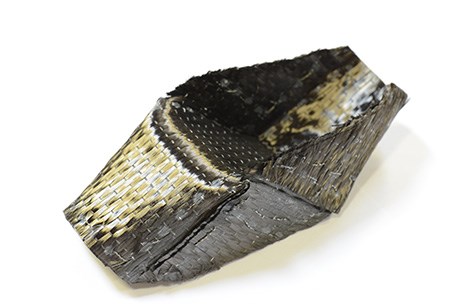Seriforge: A new paradigm for composite preforms
Silicon Valley startup aims to produce complex 3D carbon fiber preforms with z-axis reinforcement at mass production scale using automated processing lines.

Source: Seriforge
Seriforge is new to the composites industry, but its principals have a long history in solving complex 3D problems using digital technology and mechatronics (combination of electronics with mechanical engineering and computer engineering). Their goal: nothing less than to revolutionize composite parts manufacturing. Their method: use digital technology and control systems engineering to solve the age-old problem of how to make complex composite parts quickly.
How quickly? “Our focus is on industrial-scale production,” says Seriforge VP of business development, Marco Zvanik, “long-term, we’re targeting 10,000-20,000 parts/month using a single automated processing line.” But this is about preforms, right? To produce parts, there would still be additional operations required, like resin transfer molding (RTM)? Yes, Seriforge is targeting preforms, but in future iterations it will also be able to cure these preforms. But that’s looking forward. Let’s look at what the company has achieved so far.
The original idea was to create complex fiber preforms directly from CAD models, including z-axis reinforcement where needed. This would eliminate the time-consuming and error-prone manual operations of cutting, splicing and stacking. Stitching is used to bind the preform layers together, which increases delamination and impact resistance, but unlike Z-pinning (see 3rd & 4th paragraphs, “3-D woven reinforcements update”), Seriforge uses a continuous carbon fiber stitch that does not have loops or knots, which normally disturb load-bearing fibers. “There is also no disruption in the preform surface,” says Zvanik.
The details of Seriforge’s fully automated process are proprietary, but the basic paradigm shift is to decouple 3D textile preforming from a loom and broadgoods mindset. Instead, envision a 3D printing machine where multiple different 2D materials — e.g. woven or uni fabrics, veils, plastics, films — are cut, oriented and stacked. As they are being stacked they may be stitched to adjacent layers or all the way through the preform, depending upon the digital design. A wide variety of fibers can be used for the preforms, but carbon is currently the most popular. Carbon fiber is also used for the stitch yarn, but other yarn types may be used as well. Seriforge's process can also stitch through core materials such as foam.
The company has the capability to take a CAD model of a part and generate a flat, “unfolded” preform with fiber placement optimized for load, and then fold that into its 3D net-shape form. If the part comprises developable surfaces, then no darts or cuts are needed. If not, then Seriforge’s software can program these accordingly to achieve the final part shape and load requirements.
Zvanik says the process does not require separate forming tools, but instead uses an ingenious system of part-specific cartridges with automated folding and forming built-in. “We want to provide a solution not just for large OEMs and Tier 1 suppliers that want to make 100,000 plus parts per year,” Zvanik explains, “but also for companies that want to make 100 or 1,000 complex parts and cannot afford the cost of preform tooling.”
Seriforge will sell preforms and parts, not machines. “Our process won’t do prepreg and it doesn’t compete well with prepreg for thin-walled tubes and panels,” says Zvanik, “but we can offer dramatic cycle time and cost savings as preform size, thickness and complexity increases.” He notes the company is already working with 10-12 different manufacturers, targeting aerospace, automotive, oil & gas and recreational products. “We have a pipeline of applications in development ranging from near-term to long-term commercialization,” he explains.
Related Content
Sulapac introduces Sulapac Flow 1.7 to replace PLA, ABS and PP in FDM, FGF
Available as filament and granules for extrusion, new wood composite matches properties yet is compostable, eliminates microplastics and reduces carbon footprint.
Read MoreCarbon fiber, bionic design achieve peak performance in race-ready production vehicle
Porsche worked with Action Composites to design and manufacture an innovative carbon fiber safety cage option to lightweight one of its series race vehicles, built in a one-shot compression molding process.
Read MoreThe potential for thermoplastic composite nacelles
Collins Aerospace draws on global team, decades of experience to demonstrate large, curved AFP and welded structures for the next generation of aircraft.
Read MoreLarge-format 3D printing enables toolless, rapid production for AUVs
Dive Technologies started by 3D printing prototypes of its composite autonomous underwater vehicles, but AM became the solution for customizable, toolless production.
Read MoreRead Next
“Structured air” TPS safeguards composite structures
Powered by an 85% air/15% pure polyimide aerogel, Blueshift’s novel material system protects structures during transient thermal events from -200°C to beyond 2400°C for rockets, battery boxes and more.
Read MoreVIDEO: High-volume processing for fiberglass components
Cannon Ergos, a company specializing in high-ton presses and equipment for composites fabrication and plastics processing, displayed automotive and industrial components at CAMX 2024.
Read MorePlant tour: Daher Shap’in TechCenter and composites production plant, Saint-Aignan-de-Grandlieu, France
Co-located R&D and production advance OOA thermosets, thermoplastics, welding, recycling and digital technologies for faster processing and certification of lighter, more sustainable composites.
Read More






















